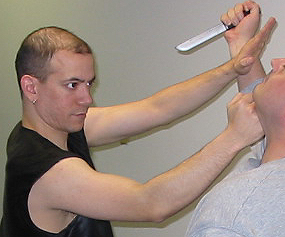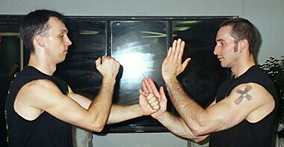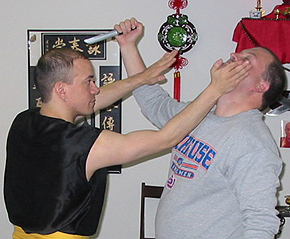its paid sponsors, whose products you need!
| Home |
| Intro |
| Current Issue |
|
Mailing List |
| Store |
| Strength |
| Subscriber Content |
| ARCHIVES
|
| Martialism |
| Pacifism |
| Q & A |
| Cunning-Hammery |
| Advertise With Us |
| Submit An Article |
| Staff |
| Discussion Forum |
| Links |
“Stay ‘unreasonable.’ If you
don’t like the solutions [available to you], come up with your
own.”
Dan Webre
The Martialist does not
constitute legal advice. It is for ENTERTAINMENT
PURPOSES ONLY.
Copyright © 2003-2004 Phil Elmore, all rights
reserved.
Wing Chun: Effective Close
Combat
By Anghony Iglesias with Phil Elmore
Sifu Anthony Iglesias runs the Syracuse
Wing Chun Academy. An accomplished martial artist with a background
encompassing several styles, Sifu Iglesias agreed to answer a few questions
about the art he calls “his specialty” — Wing Chun Kung Fu.
How long have you been involved in the martial
arts? What arts have you studied?

I started my martial arts journey in 1979. I was a crazy little guy, very small
and fearless. My brother and his best friend were very worried that I would
get killed because I would fight anyone, no matter what their size. This
resulted in my getting beat up often. They decided I needed discipline.
At the time my brother was training at an Ishin
Ryu dojo and his best friend was his senior. They both started training me every
chance they got in that style and also in Western boxing. I was very excited to
learn from them, especially being a big fan of Bruce Lee and the Saturday
afternoon martial art films in New York City.
They did have one condition however: I was not
allowed to fight. The rules were that if I got into a fight from which I could
have walked away they would cease my training. They were true to their words.
They constantly drilled it into my head that fighting is wrong and that a true
martial artist uses his mind and not his fists.
When I hit my teens, I started watching different
stick fighters and that started my interest in Kali/Escrima. I started
collecting books and videos and tried to absorb every bit of information I
could. I learned mainly from watching Guro Dan Inosanto. Later I was lucky
enough to get “fine tuned” by a fellow classmate who was personally
trained by Guro Inosanto. In the early 1990s I met with Sifu James O’Brian and
started training in White Crane Gung fu.
What characterizes White Crane? How is it
different from, say, Karate?
 I
I
found White Crane to be more flowing. There was more continuity of movement. It
fit my personality much more closely then Karate. The footwork is very evasive
and demanding and the hand movement is very effective in defusing energy. White
Crane is also characterized by striking fast with power.
Why did you switch from White Crane to Wing Chun?
Well, I never really switched. My training in White Crane was very
satisfying in many ways, but I always wanted to learn more about this art that
Bruce Lee studied. I also heard Guro Inosanto make mention of it several times.
I read about it and started collecting books. I
searched for a nearby Wing Chun school and found one in the town I was living in
at the time. I called them and checked it out. I was very disappointed. I can’t
remember the name of the school or the instructors, but I felt there was
something missing. I didn’t agree with anything they were saying nor did I agree
with their particular style of Chi Sau [sticky hands].
I remember watching them, thinking, “You’re
teaching them bad habits. They’ll get hit doing that.” I left feeling
pretty bummed out but I knew that this must have been a poor representation of
Wing Chun. So I kept searching. One day I got lucky and found a school in
Buffalo, NY that was in the lineage of Grandmaster William Cheung. The school
was over an hour’s drive, but I needed to find out if this school would be
anything like the last one.
When I got there everyone was very warm and
friendly. The Sifu welcomed me and started teaching class. I watched in awe and
knew that this was the school for me. A funny memory I have was of my first day
in class. Sifu saw me doing some really bad Wing Chun movement that I learned
from a video. Sifu said, “Don’t do that.” He proceeded to start me on
basics. I later learned that the movement I was doing was very wrong.
Why did you select the Cheung lineage?
I keep an open mind to all that is Wing Chun, but I must say that I give credit
to Cheung style Wing Chun for its more realistic approach to fighting. I’ve
always lived by the rule that if you have evasiveness in footwork then your
hands will be enhanced. Cheung style emphasizes footwork more then the other
styles of Wing Chun. They never stay on the attacking line. I chose Cheung style
because it was much closer to my training in White Crane than the other
lineages.

Can you give us some background
on Wing Chun? How is it similar and different to other well-known styles?
Well, Wing Chun can be defined as simplicity at it’s finest. It cuts through
fanciness and gets to the core of combat. It has remained relatively unchanged
since its creation, which in my opinion shows what a complete system it is.
I often read about people changing
the styles they were taught to fit with modern times. and for the most part they
had to, because their art was created to deal with a specific kind of fighting
style. Wing Chun is based on fighting principles and strategies that have stood
the test of time. Hand to hand combat is like the law of gravity. There are
certain truths that cannot be denied. There are things that need to be done in
order for someone to hurt you. Like Bruce Lee said, “In order to hit me you
must first move to me. Therein lies my opportunity to intercept you.”
Wing Chun uses only what is
necessary for self defense. There is no wasted movement. It’s hard to really say
how Wing Chun is different from other systems without sounding like I’m
badmouthing them. I guess all I can say is, to many people, Wing Chun is not
pretty. It’s not used to win forms competitions or sparring tournaments. It was
created to make effective fighters in very little time.
What are the principles of Wing Chun?
The principles vary from school to school, but in Cheung style they are these:
-
Guard the Center
-
Face the Point of Contact
-
Economy of Movement
-
Touch Reflexes
-
Chi Sao
-
Watch the Leading Elbow
-
Use Linear Striking Action
-
Avoid Fighting Force Against
Force -
Train to Use Two Arms at the
Same Time -
Use Pressure Points to Make
Striking Techniques More Effective -
Use the Same Meridian
Pressure Points for Treatment of Sports Injuries
There is also a saying that I think is important: Lui
lao hui soong. Lut sao jik chung. This translates to, Receive
what comes, accompany what leaves. Charge straight when free.
Why is Wing Chun an effective close-combat art for *realistic* fighting?
Wing Chun is effective for close combat because that is where all fights end
up. Very rarely will someone allow you to “get ready” for their
attack. Usually it is a flurry of fists that result in both parties getting
injured. Wing Chun emphasizes close quarters awareness and touch reflexes.
This skill translates to immediate reaction once a bridge has been made.
Unfortunately, there are many Wing Chun schools that lose
sight of this reality and start changing the system. Whether at a distance or
up close, standing up or on the ground, Wing Chun principles are effective in
self-defense. The most important skill, however, is the practitioners’ ability
to do it with meaning. All too often people learn a physical skill
without working on the mental skill required to be a fighter.

How do you address use-of-force
issues in your class — specifically, the legal dangers of striking someone
first if they get too close?
Well, the use of force is always the last option. You should exercise good
common sense when dealing with a possibly life-threatening situation. If you are
only arguing with someone, then you should just keep your distance and try to
calm down the other individual. Do not yell back, as this will escalate the
situation into the next level of anger and give witnesses evidence against you
in case police get involved.
If the person throws up his or her
into a fighting position, you have no choice but to defend yourself. Again, keep
calm and tell the attacker that you do not wish to fight. Stay as far away from
him or her as possible, but if the attacker throws a punch or gets too close,
protect yourself. It has been shown that even if the other guy throws the first
punch, the person left standing is usually the one in trouble, especially if he
used excessive force. Wing Chun does the job and no more. The strikes are
targeted for quick knockouts. That is Wing Chun’s “mercy” — a
quick end to the fight.
Have you ever used Wing Chun to defend yourself in a “real life”
scenario? If so, can you describe how the art helped you?
I have been “put to the test” on many occasions, be they in real
fights or in breaking up skirmishes among others. Just this past weekend in West
Springfield, MA, I was quietly sitting with some friends enjoying some breakfast
at around 11 a.m. Suddenly a fight between two young adults erupted.
Without thinking I got up and ran over to break it up.
When I got there I saw one man
winding up to punch the other. I immediately stepped in and diffused his attack
with out harming him and successfully separated the two individuals. The
aggressor of the two ran off while I made sure the other was ok. I asked a
waitress to call the police when a man who was standing with me said, “I’m
a police officer. Hey… Good work, friend.” Assured that the situation was
now under control, I went back to my breakfast.
I grew up on the streets of New York
City and fighting was a way to gain respect. I was also one of the only Latin
people in an all-Italian neighborhood. I used to be proud of all the fights I’ve
been in, but now I just thank God that I’m still alive.
My White Crane grandmaster once said
“The best Gung Fu man never fights.”
I took that to
heart and maintain that way of life today.

